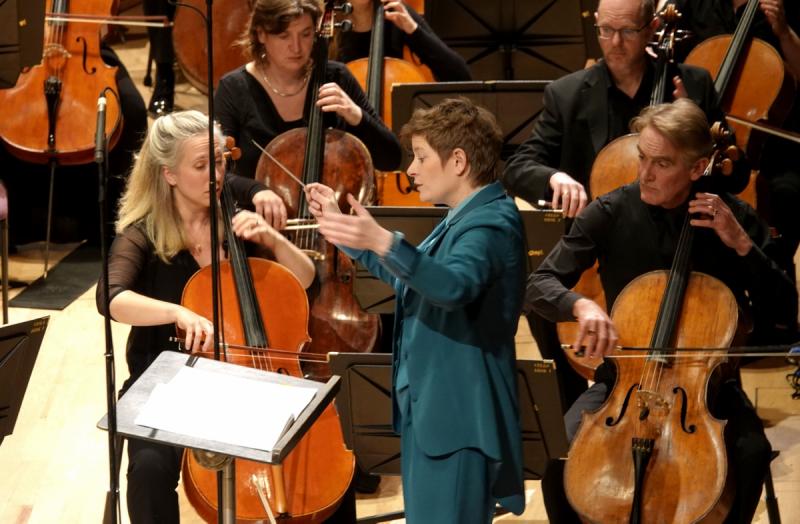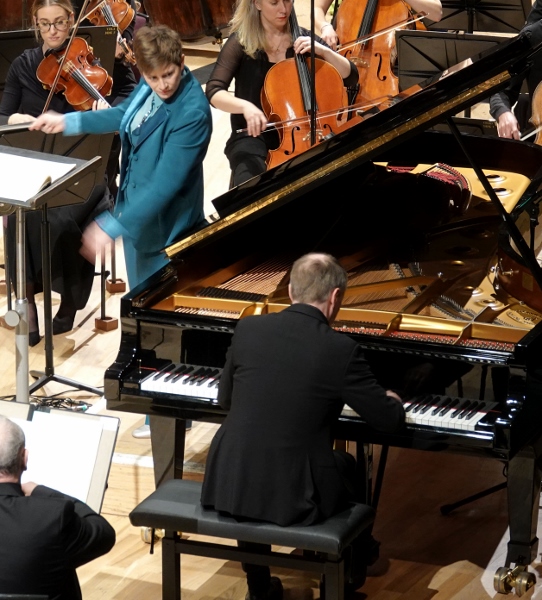Osborne, BBC Philharmonic, Bihlmaier, Bridgewater Hall, Manchester review - an orchestra at the top of its game | reviews, news & interviews
Osborne, BBC Philharmonic, Bihlmaier, Bridgewater Hall, Manchester review - an orchestra at the top of its game
Osborne, BBC Philharmonic, Bihlmaier, Bridgewater Hall, Manchester review - an orchestra at the top of its game
Another Bruckner symphony for the 200th anniversary year

Just a few days after the Hallé’s Bruckner 8, the BBC Philharmonic weighed in with his Seventh Symphony for its Manchester audience. We’re all getting a lot of Bruckner in his 200th anniversary year, and this was a wise choice, being one of his shorter creations in the genre – only about an hour and 10 minutes in playing time – and containing some of his best melodic ideas and rhythmic inventions.
It also benefits from the tonal qualities of an orchestra at the top of its game to realise the richness of the textures he created, and this was amply fulfilled in the sound of the Philharmonic, with Yuri Torchinsky in the leader’s chair.
Bruckner brought a chorus of four “Wagner tubas” to the mix in this symphony (as he did again for the Eighth), using them particularly in his Adagio movement with the bass tuba beneath. Conductor Anja Bihlmaier had the bass tuba up sticks from his familiar spot alongside the trombones and join them (and the horns) for that movement, then move back again for the remainder of the work: those listening on Radio 3 in two months’ time with good stereo may be able to track his spatial transitioning.
Her interpretation was a compelling one. Bruckner asked for “very slow” in the Adagio and “not fast”, followed by several calls for “broad”, “slowing” and “slow” in the finale (the atmosphere of cathedral worship, in which he often took part as organist, perhaps a part of his aspiration), but in practice it helped to keep things moving. Her approach made structures clear – the opening movement, after a slightly diffident beginning, soon picked up its stride and the second main theme was warm and rich, with the third one simultaneously insistent and thoughtful.
The Adagio flowed beautifully, its second theme poised and graceful. New soundscapes were revealed in considerable glory, especially at the first unveiling of the full brass sound, at the climax of the movement, and in the dramatic unison horns’ entry shortly before the final epilogue.
The Scherzo third movement is the one real opportunity for high spirits in the symphony, and it had them in full measure – almost with vehemence. Phrases were eloquently shaped with a light but intelligent touch, and Bihlmaier knew how to let melody lead the way (at the close of the Trio, especially). The finale, very sensibly, was frequently energetic, with impetus recovered whenever those markings indicated it should be.
 The symphony was set alongside Beethoven: his Fifth Piano Concerto, with Steven Osborne the soloist (pictured left). No surprise that the orchestral strings body was smaller here than for Bruckner, but in reality the 41 of them (one more double bass than a straight even-numbers list might prescribe) were a pretty hefty bunch, and he seemed to like to match the muscular sound they made. He opened with the concerto’s surprise cadenza-style effusions in grand style (oddly, the third piano-and-tutti chord not quite in sync both at the outset and in its reprise), and then there was a graceful, swaying contrast, first from the orchestra at Bihlmaier’s behest and then from the piano, in the second main theme. Contrast and a wide range of power were the order of the day (more than would have been possible on pianos of Beethoven’s day, probably, but there’s a whole tradition of big-boned playing in Beethoven concertos), and very effectively so.
The symphony was set alongside Beethoven: his Fifth Piano Concerto, with Steven Osborne the soloist (pictured left). No surprise that the orchestral strings body was smaller here than for Bruckner, but in reality the 41 of them (one more double bass than a straight even-numbers list might prescribe) were a pretty hefty bunch, and he seemed to like to match the muscular sound they made. He opened with the concerto’s surprise cadenza-style effusions in grand style (oddly, the third piano-and-tutti chord not quite in sync both at the outset and in its reprise), and then there was a graceful, swaying contrast, first from the orchestra at Bihlmaier’s behest and then from the piano, in the second main theme. Contrast and a wide range of power were the order of the day (more than would have been possible on pianos of Beethoven’s day, probably, but there’s a whole tradition of big-boned playing in Beethoven concertos), and very effectively so.
In the slow movement the muted strings created a delicate cushion of sound, and the piano, beginning una corda, followed their example… before passion made itself felt. It was eloquent and a model of classic sensibility. The finale was rhythmically energised, its three-in-a-bar dancing along: soloist and conductor equally delighted with its effect, and so they were entitled to be.
Osborne added a gentle wisp of a miniature by way of encore, based on a theme by Keith Jarrett.
- To be broadcast on Radio 3 on 8 May
- More classical reviews on theartsdesk
rating
Share this article
The future of Arts Journalism
You can stop theartsdesk.com closing!
We urgently need financing to survive. Our fundraising drive has thus far raised £49,000 but we need to reach £100,000 or we will be forced to close. Please contribute here: https://gofund.me/c3f6033d
And if you can forward this information to anyone who might assist, we’d be grateful.

Subscribe to theartsdesk.com
Thank you for continuing to read our work on theartsdesk.com. For unlimited access to every article in its entirety, including our archive of more than 15,000 pieces, we're asking for £5 per month or £40 per year. We feel it's a very good deal, and hope you do too.
To take a subscription now simply click here.
And if you're looking for that extra gift for a friend or family member, why not treat them to a theartsdesk.com gift subscription?
more Classical music
 Robin Holloway: Music's Odyssey review - lessons in composition
Broad and idiosyncratic survey of classical music is insightful but slightly indigestible
Robin Holloway: Music's Odyssey review - lessons in composition
Broad and idiosyncratic survey of classical music is insightful but slightly indigestible
 Classical CDs: Wolf-pelts, clowns and social realism
British ballet scores, 19th century cello works and contemporary piano etudes
Classical CDs: Wolf-pelts, clowns and social realism
British ballet scores, 19th century cello works and contemporary piano etudes
 Bizet in 150th anniversary year: rich and rare French offerings from Palazzetto Bru Zane
Specialists in French romantic music unveil a treasure trove both live and on disc
Bizet in 150th anniversary year: rich and rare French offerings from Palazzetto Bru Zane
Specialists in French romantic music unveil a treasure trove both live and on disc
 Scottish Chamber Orchestra, Ibragimova, Queen’s Hall, Edinburgh review - rarities, novelties and drumrolls
A pity the SCO didn't pick a better showcase for a shining guest artist
Scottish Chamber Orchestra, Ibragimova, Queen’s Hall, Edinburgh review - rarities, novelties and drumrolls
A pity the SCO didn't pick a better showcase for a shining guest artist
 Kilsby, Parkes, Sinfonia of London, Wilson, Barbican review - string things zing and sing in expert hands
British masterpieces for strings plus other-worldly tenor and horn - and a muscular rarity
Kilsby, Parkes, Sinfonia of London, Wilson, Barbican review - string things zing and sing in expert hands
British masterpieces for strings plus other-worldly tenor and horn - and a muscular rarity
 From Historical to Hip-Hop, Classically Black Music Festival, Kings Place review - a cluster of impressive stars for the future
From quasi-Mozartian elegance to the gritty humour of a kitchen inspection
From Historical to Hip-Hop, Classically Black Music Festival, Kings Place review - a cluster of impressive stars for the future
From quasi-Mozartian elegance to the gritty humour of a kitchen inspection
 Shibe, LSO, Adès, Barbican review - gaudy and glorious new music alongside serene Sibelius
Adès’s passion makes persuasive case for the music he loves, both new and old
Shibe, LSO, Adès, Barbican review - gaudy and glorious new music alongside serene Sibelius
Adès’s passion makes persuasive case for the music he loves, both new and old
 Anja Mittermüller, Richard Fu, Wigmore Hall review - a glorious hall debut
The Austrian mezzo shines - at the age of 22
Anja Mittermüller, Richard Fu, Wigmore Hall review - a glorious hall debut
The Austrian mezzo shines - at the age of 22
 First Person: clarinettist Oliver Pashley on the new horizons of The Hermes Experiment's latest album
Compositions by members of this unusual quartet feature for the first time
First Person: clarinettist Oliver Pashley on the new horizons of The Hermes Experiment's latest album
Compositions by members of this unusual quartet feature for the first time
 Gesualdo Passione, Les Arts Florissants, Amala Dior Company, Barbican review - inspired collaboration excavates the music's humanity
At times it was like watching an anarchic religious procession
Gesualdo Passione, Les Arts Florissants, Amala Dior Company, Barbican review - inspired collaboration excavates the music's humanity
At times it was like watching an anarchic religious procession
 Classical CDs: Camels, concrete and cabaret
An influential American composer's 90th birthday box, plus British piano concertos and a father-and-son duo
Classical CDs: Camels, concrete and cabaret
An influential American composer's 90th birthday box, plus British piano concertos and a father-and-son duo
 Cockerham, Manchester Camerata, Sheen, Martin Harris Centre, Manchester review - re-enacting the dawn of modernism
Two UK premieres added to three miniatures from a seminal event of January 1914
Cockerham, Manchester Camerata, Sheen, Martin Harris Centre, Manchester review - re-enacting the dawn of modernism
Two UK premieres added to three miniatures from a seminal event of January 1914

Add comment